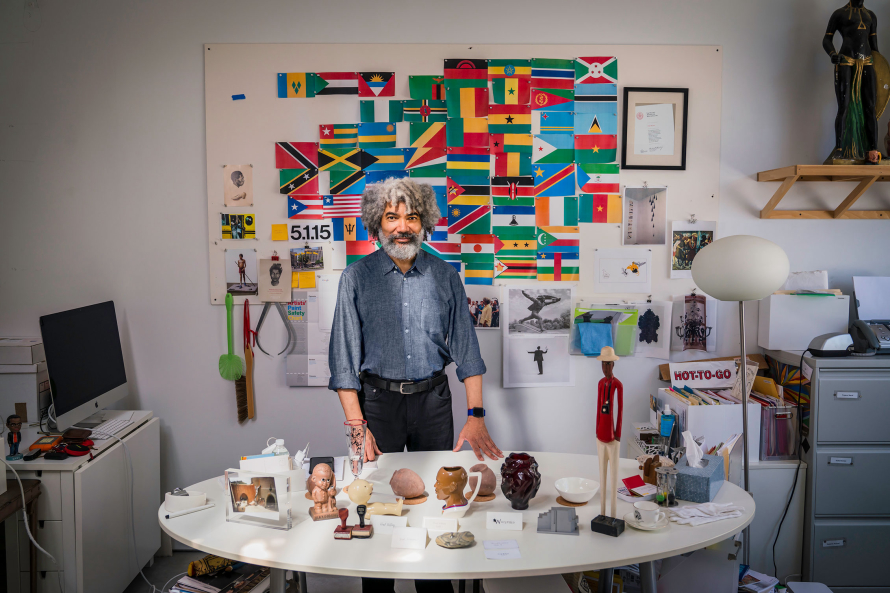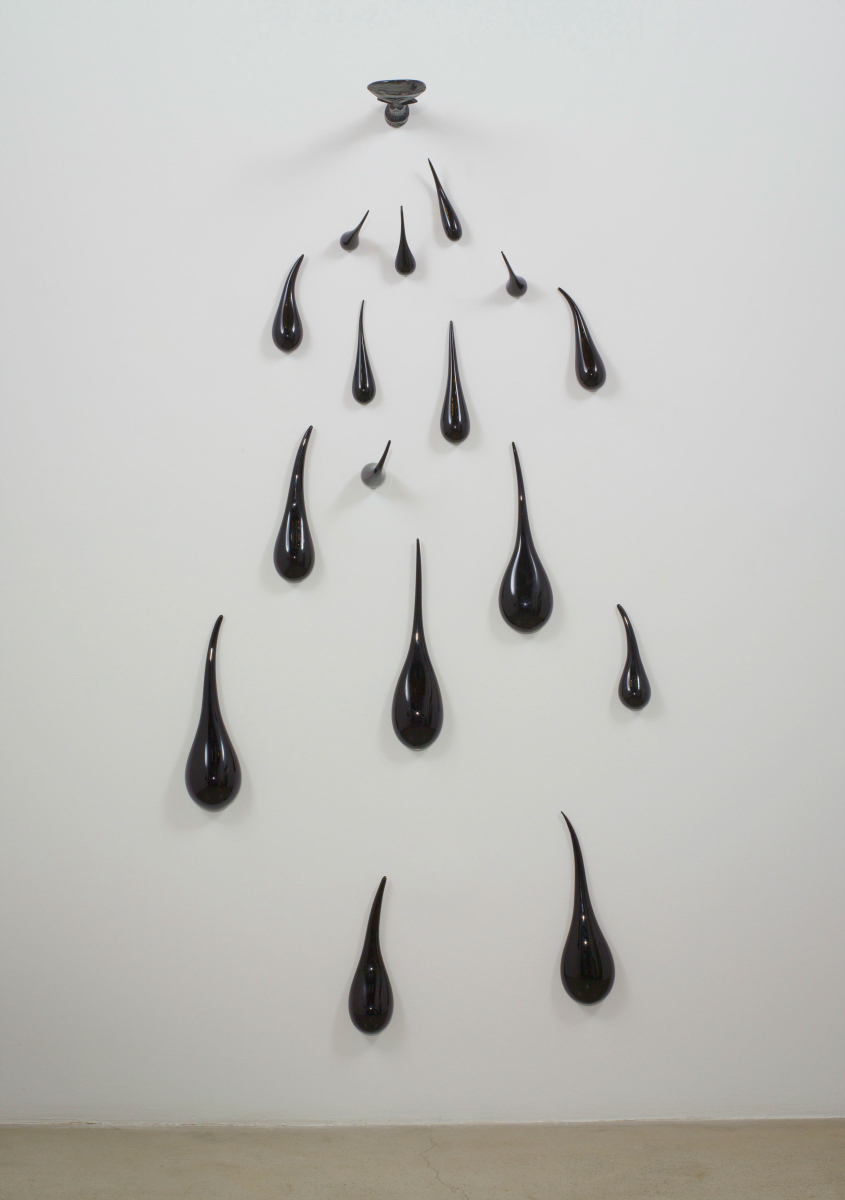
Fred Wilson’s Chandeliers are much more than a dazzling feat of glassmaking. They are a testament to a career-long study of unearthed histories and injustices of cultural representation. Deceptively straightforward, the 1999 MacArthur “Genius” grantee articulates institutional erasure and racism in global networks, whether exposing the underbelly of museum collections or the cultural abrasions of ancient cities.
Critics have hailed Wilson’s practice as both metamuseology and virtuosic appropriation. The artist himself calls it trompe-l’oeil curating. For “Mining the Museum,” his seminal 1992 Baltimore exhibition, Wilson exhumed artifacts from the Maryland Historical Society storage, placing typical white, upper-crust objects alongside horrifying ones: a Ku Klux Klan hood placed inside an Edwardian baby stroller; ornate 19th-century chairs juxtaposed with a slave whipping post. More than a decade later, Wilson dug into Dartmouth’s Hood Museum of Art, discovering a life-sized plaster cast of Ota Benga, a man kidnapped from what is now the Democratic Republic of Congo and exhibited in an iron cage at the Bronx Zoo and as a “real Pygmy” in an anthropology exhibit at the 1904 St. Louis World’s Fair. By elevating Ota Benga’s bronze bust on a nearly five-foot plinth, the man’s actual height, and knotting a white silk scarf around his neck, Wilson asks uncomfortable questions about relics taken for granted in a museum: what violence and cultural deletion brought this art to this place?
As the 2003 United States representative to the Venice Biennale, Wilson displayed indigenous caricatures—including commonplace “blackamoor” figurines scavenged from the ancient city—to expose the racial dynamics of the Venetian Republic. Here, Wilson also unveiled his famed Murano chandelier series, five of which inaugurate Pace Gallery’s new 75,000-square-foot, eight-story Chelsea headquarters. Each one titled from dialogue spoken by Shakespeare’s Othello (“The Moor of Venice”), Wilson commissioned the chandeliers in the traditional Rezzonico style, but in black glass, calling attention to 18th-century Venice’s rarely acknowledged African population. For his Afro Kismet chandeliers, part of a larger installation he first showed at the 2017 Istanbul Biennial, he stitched together elements of Venetian and Ottoman design based on his inquiries into Arab culture and the local slave trade. In A Moth of Peace (2018), part of Pace’s lineup, subtle black accents fleck the glossy white Murano glass.

Absent any background, viewers would be forgiven for mistaking “Fred Wilson: Chandeliers” as a showcase of decorative art mastery and immaculate craftsmanship. Suspended from Pace’s 19-foot ceilings on the seventh floor, with its 17-foot high glass windows and polished concrete floor, the installation is as much a meditation on grandeur, beauty and formalism as anything else. And with works by Alexander Calder, David Hockney, and Loie Hollowell in the galleries below, Pace’s new flagship is nothing short of a museum.
It is a humid summer Saturday when Wilson and I meet to discuss Chandeliers at his Williamsburg studio—a 1930s speakeasy turned heating and air conditioning company that had become a car garage by the time he bought the property in the aftermath of the 9/11 attacks, with the proceeds from his MacArthur Foundation award. During renovations, he recalls unearthing liquor bottles beneath the floor. In the art world, Wilson is well known for being generous, with an unfailing sense of humor and warmth. This is evident the moment he opens the door with a huge smile, apologizing for the jury duty that has required us to meet on a weekend. Flip-flops, white linen shirt and shorts evince an allergy to pretension and art speak. I’m reminded instantly of his 1991 work, Guarded View, comprised of four, headless black mannequins wearing museum guard uniforms from MoMA, The Met, The Jewish Museum, and the Whitney (where Wilson is now a trustee). Inspired by his experience working as a museum guard and the invisibility of that role, the artwork is a commentary on the lack of African-American curators and directors: who decides what gets displayed? At the same time, Guarded View illustrates Wilson’s abiding generosity to his viewers, meeting us wherever we are prepared to engage on systems of power.
“They’re sort of alien beings,” Wilson tells me, when I ask him to describe the chandeliers. “I had been working with black glass specifically because I’m interested in notions of blackness and what that means in all kinds of symmetrical ways.” Indeed, at Pace this fall, there are three ebony black sculptures that exemplify blackness as a racial category but also as an experience of isolation and melancholy. “I’m always trying to find where the conversation is not going or these things that are unspoken that maybe people are not aware of,” Wilson explains. “My way of communicating is essentially through displaying tensions.”
“I don’t try to make chandeliers beautiful,” he confesses. “But with a chandelier it just comes back to the beauty factor, especially working with the Venetians, who are a highly aesthetic people.” Sun streams through the aluminum, gallery-style garage door, a wall of Wilson’s signature black blown glass tear or raindrop pieces cascade behind him. Later, he texts that the glass drips may need some tweaking before they are ready for the gallery. “There are things in this world that are still questions, even though they’ve been around for a long time,” he says of the underlying themes in Chandeliers. “They’re unexamined until you isolate them. When you’re in the middle of a culture, you don’t necessarily notice all of it.”
The same unintentional beauty defines Wilson’s celebrated African flag paintings in which each country’s flag is outlined in black acrylic, removing color to heighten the visual language of representation. The artworks harken Sol LeWitt’s abstract murals and Agnes Martin’s canvases, but Wilson’s conceptualism, and an institutional critique of iconography itself, occupies a deeper and far more disquieting space.
“Chandeliers are important cultural signifiers,” wrote artist duo and curators of the 2017 Istanbul Biennial Elmgreen & Dragset. “Wilson’s tell the story of cultural influences and traces of a history that is different from the dominant one that we are normally taught. Before his 2017 installation, the economic and social relationship between the Venetian and Ottoman empires were largely unknown. Chandeliers reveal how cultures have always been interconnected through trade routes and imperialism, exploitation and oppression,” but, they also say, “through fascination and desire for the other as well. While at first you may be captivated by the beauty of Wilson’s art, they caution: ‘the more you look, the darker and sometimes more shocking the work gets.’”










 in your life?
in your life?

